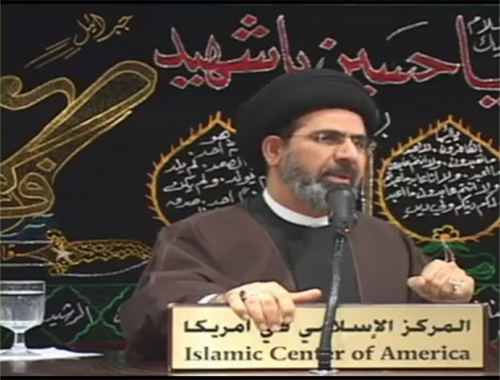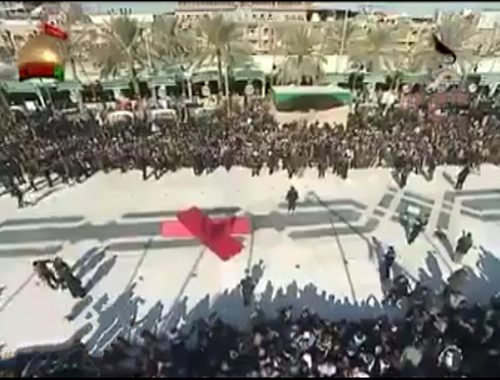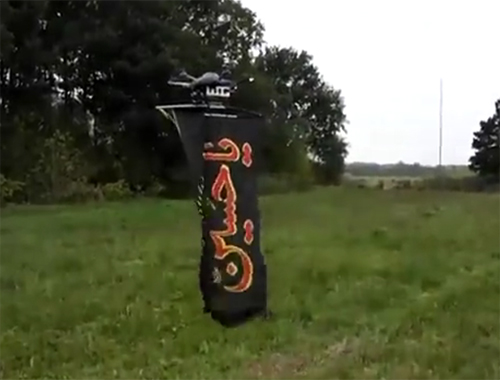Articles
Zayd ibn Ali ibn al-Hussain (AS)
- Details
- Hits: 62218
 Zayd ibn Ali (695-740 C.E.) He was given the title "Zayd the Martyr" (Zayd ash-Shahid) by his sympathizers. He was the grandson of Husayn ibn Ali(AS), the grandson of Hazrat Muhammad (p.b.u.h). Zayd was born in Medina in 695. His father was Ali ibn Husayn (AS), The fourth Imam. His mother was a concubine of Indian origin.[1]
Zayd ibn Ali (695-740 C.E.) He was given the title "Zayd the Martyr" (Zayd ash-Shahid) by his sympathizers. He was the grandson of Husayn ibn Ali(AS), the grandson of Hazrat Muhammad (p.b.u.h). Zayd was born in Medina in 695. His father was Ali ibn Husayn (AS), The fourth Imam. His mother was a concubine of Indian origin.[1]Zayd led a rebellion known as the Zaidi Revolt against the Umayyads in the middle of 8th century, renewing hostilities that existed between the Umayyads and the Hashemites. Zayd was killed during fighting in 740. The Zaydi Revolt was a failed rebellion led by Zayd ibn Ali in 740 against the Umayyad dynasty, who had taken over the Islamic Caliphate since the death of his great-grandfather, Ali. ...

His Death
Muhammad prophesied his death, as narrated by Imam Husayn:
"The Holy Prophet put his sacred hand on my back and said: 'O Hussain, it will not be long until a man will be born among your descendants. He will be called Zaid; he will be killed as a martyr. On the day of resurrection, he and his companions will enter heaven, setting their feet on the necks of the people.'" [2]
Historians of both Shi'is and Sunnis recorded that when Hisham ibn Abdu'l-Malik became the caliph, he committed many atrocities. With regard to the Bani Hashim, he was particularly cruel. At last, Zaid ibn ‘Ali, well known as a great scholar and a pious theologian, went to see the caliph to seek redress for the grievances of the Bani Hashim.
As soon as Zaid arrived, the caliph, instead of greeting him as a direct descendant of the prophet, abused him with such abominable language that it can not be repeated. Because of this disgraceful treatment, Zaid left Syria for Kufa, where he raised an army against the Bani Umayyad.
The governor of Kufa, Yusuf ibn 'Umar Thaqafi came out with a huge army to face him. Zayd recited the following war poem: "Disgraceful life and honourable death: both are bitter morsels, but if one of them must be chosen, my choice is honourable death." Although he fought bravely, Zayd was killed in battle on the 2nd of Safar in 120 A.H. at the age of forty-two by Yusuf ibn 'Amr al-Thaqafi (the Umayyad governor).
His son, Yahya, took his body from the field and buried him away from the city near the river bank, causing the water to flow over it. However, the grave was discovered and, under Yusuf's orders, the body was exhumed, Zayd's head was cut off and sent to Hisham in Syria. In the month of Safar, 121 A.H., Hisham had the sacred body of this descendant of the Prophet placed on the gallows entirely naked. For four years the sacred body remained on the gallows. Thereafter, when Walid Ibn Yazid ibn Abdu'l-Malik ibn Marwan became caliph in 126 A.H., he ordered that the skeleton be taken down from the gallows, burnt, and the ashes scattered to the wind.
This accursed man committed a similar atrocity to the body of Yahya ibn Zayd of Gurgan (or Jowzjan). This noble man also opposed the oppression of the Bani Umayyad. He too was martyred on the battlefield. His head was sent to Syria and, as in the case of his revered father, his body was hung on the gallows - for six years. Friend and foe alike wept at the sight. Waliu'd-din Abu Muslim Khorasani, who had risen against the Bani Umayyad on behalf of Bani 'Abbas, took his body down and buried it in Gurgan (or Jowzjan). In Sarakhs however, there is a site of pilgrimage at Miyami.[3]}}
Claims to the Imamate
After his death, some felt that he was the rightful successor to his father, rather than his half-brother Muhammad al-Baqir. Those who believe in this line of succession form the Zaidi sect within Shi'a Islam.
Due to the fact that Zaid ibn 'Ali led a rebellion via Jihad against the Umayyad Caliphate, certain Shiites were under the impression that Zaid was claiming imamate for himself and therefore started believing in him as the Imam. This is what developped into the Zaidi sect of Shi'a Islam by his companions.
The Ithna 'Ashari sources do not believe that Zaid claimed imamate for himself. Shaykh Mufid states "However that was not his intention because he knew of the right of his brother, peace be on him, to the Imamate before him, and of his bequest of trusteeship (wasiyya) at his death to Abu 'Abd Allãh (i.e., Jafar as-Sadiq), peace be on him." [4]
There is no evidence in the relationship between Imam Jafar as-Sadiq and Zaid ibn Ali that would demonstrate that Zaid ibn ‘Ali was claiming the Imamate for himself. When Imam Jafar as-Sadiq was informed about Zaid ibn Ali's martyrdom, "he was very sad...and he set apart a thousand dinars of his own money for the families of those of (Zaid's) followers who were killed with him." [5]
His Character
Shaykh Mufid describes him as "a devout worshipper, pious, a jurist, God-fearing and brave." [7]}}
It is worth mentioning that he is also the first narrator of the famous as-Sahifah as-Sajjãdiyya of Imam Zainul 'Abidin.
Shrines
There are two shrines for Zayd, One is in Kufa, Iraq, the other is in Karak, Jordan. The shrine in Jordan may be the final resting place for the head of Zayd ibn ‘Ali ibn Al-Husayn. He was the great, great, grandson of Prophet Mohammad and a religious leader known for his righteous, majestic and knowledgeable ways. When descriibng Zaid, Imam Ja'far Al-Sadiq said: "Among us he was the best read in the Holy Qur'an, and the most knowledgeable about religion, and the most caring towards family and relatives."[8]}}
References
1.Madelung, W. "Zayd b. ʿAlī b. al- Ḥusayn ." Encyclopaedia of Islam. Edited by: P. Bearman , Th. Bianquis , C.E. Bosworth , E. van Donzel and W.P. Heinrichs. Brill, 2007. Brill Online. 13 September 2007 [1]
2.Article by Sayyid 'Ali ibn 'Ali Al-Zaidi, A short History of the Yemenite Shi‘ites (2005) Referencing: Peshawar Nights by Sultanu'l-Wa'izin Shirazi
3.Article by Sayyid 'Ali ibn 'Ali Al-Zaidi, A short History of the Yemenite Shi‘ites (2005) Referencing: al-Mufid, al-Irshad, p. 404; al-Mas'udi, Muruj adh-Dhahab; al-Qummi, Muntahal Amãl, p. 36
4.Article by Sayyid 'Ali ibn 'Ali Al-Zaidi, A short History of the Yemenite Shi‘ites (2005) Referencing: al-Irshad, p. 404
5.Article by Sayyid 'Ali ibn 'Ali Al-Zaidi, A short History of the Yemenite Shi‘ites (2005) Referencing: al-Irshad, p. 405) For other such narrations by Shaykh as-Saduq, see Muntahal Amãl, p. 36
6.Article by Sayyid 'Ali ibn 'Ali Al-Zaidi, A short History of the Yemenite Shi‘ites (2005) Referencing: Shi'a Islam, p. 77 and S.S. Akhtar Rizvi, "Shi'a Sects"
7.Article by Sayyid 'Ali ibn 'Ali Al-Zaidi, A short History of the Yemenite Shi‘ites (2005) Referencing: al-Irshad, p. 403
8.Article by Sayyid 'Ali ibn 'Ali Al-Zaidi, A short History of the Yemenite Shi‘ites (2005)
Muhammad prophesied his death, as narrated by Imam Husayn:
"The Holy Prophet put his sacred hand on my back and said: 'O Hussain, it will not be long until a man will be born among your descendants. He will be called Zaid; he will be killed as a martyr. On the day of resurrection, he and his companions will enter heaven, setting their feet on the necks of the people.'" [2]
Historians of both Shi'is and Sunnis recorded that when Hisham ibn Abdu'l-Malik became the caliph, he committed many atrocities. With regard to the Bani Hashim, he was particularly cruel. At last, Zaid ibn ‘Ali, well known as a great scholar and a pious theologian, went to see the caliph to seek redress for the grievances of the Bani Hashim.
As soon as Zaid arrived, the caliph, instead of greeting him as a direct descendant of the prophet, abused him with such abominable language that it can not be repeated. Because of this disgraceful treatment, Zaid left Syria for Kufa, where he raised an army against the Bani Umayyad.
The governor of Kufa, Yusuf ibn 'Umar Thaqafi came out with a huge army to face him. Zayd recited the following war poem: "Disgraceful life and honourable death: both are bitter morsels, but if one of them must be chosen, my choice is honourable death." Although he fought bravely, Zayd was killed in battle on the 2nd of Safar in 120 A.H. at the age of forty-two by Yusuf ibn 'Amr al-Thaqafi (the Umayyad governor).
His son, Yahya, took his body from the field and buried him away from the city near the river bank, causing the water to flow over it. However, the grave was discovered and, under Yusuf's orders, the body was exhumed, Zayd's head was cut off and sent to Hisham in Syria. In the month of Safar, 121 A.H., Hisham had the sacred body of this descendant of the Prophet placed on the gallows entirely naked. For four years the sacred body remained on the gallows. Thereafter, when Walid Ibn Yazid ibn Abdu'l-Malik ibn Marwan became caliph in 126 A.H., he ordered that the skeleton be taken down from the gallows, burnt, and the ashes scattered to the wind.
This accursed man committed a similar atrocity to the body of Yahya ibn Zayd of Gurgan (or Jowzjan). This noble man also opposed the oppression of the Bani Umayyad. He too was martyred on the battlefield. His head was sent to Syria and, as in the case of his revered father, his body was hung on the gallows - for six years. Friend and foe alike wept at the sight. Waliu'd-din Abu Muslim Khorasani, who had risen against the Bani Umayyad on behalf of Bani 'Abbas, took his body down and buried it in Gurgan (or Jowzjan). In Sarakhs however, there is a site of pilgrimage at Miyami.[3]}}
Claims to the Imamate
After his death, some felt that he was the rightful successor to his father, rather than his half-brother Muhammad al-Baqir. Those who believe in this line of succession form the Zaidi sect within Shi'a Islam.
Due to the fact that Zaid ibn 'Ali led a rebellion via Jihad against the Umayyad Caliphate, certain Shiites were under the impression that Zaid was claiming imamate for himself and therefore started believing in him as the Imam. This is what developped into the Zaidi sect of Shi'a Islam by his companions.
The Ithna 'Ashari sources do not believe that Zaid claimed imamate for himself. Shaykh Mufid states "However that was not his intention because he knew of the right of his brother, peace be on him, to the Imamate before him, and of his bequest of trusteeship (wasiyya) at his death to Abu 'Abd Allãh (i.e., Jafar as-Sadiq), peace be on him." [4]
There is no evidence in the relationship between Imam Jafar as-Sadiq and Zaid ibn Ali that would demonstrate that Zaid ibn ‘Ali was claiming the Imamate for himself. When Imam Jafar as-Sadiq was informed about Zaid ibn Ali's martyrdom, "he was very sad...and he set apart a thousand dinars of his own money for the families of those of (Zaid's) followers who were killed with him." [5]
His Character
Shaykh Mufid describes him as "a devout worshipper, pious, a jurist, God-fearing and brave." [7]}}
It is worth mentioning that he is also the first narrator of the famous as-Sahifah as-Sajjãdiyya of Imam Zainul 'Abidin.
Shrines
There are two shrines for Zayd, One is in Kufa, Iraq, the other is in Karak, Jordan. The shrine in Jordan may be the final resting place for the head of Zayd ibn ‘Ali ibn Al-Husayn. He was the great, great, grandson of Prophet Mohammad and a religious leader known for his righteous, majestic and knowledgeable ways. When descriibng Zaid, Imam Ja'far Al-Sadiq said: "Among us he was the best read in the Holy Qur'an, and the most knowledgeable about religion, and the most caring towards family and relatives."[8]}}
References
1.Madelung, W. "Zayd b. ʿAlī b. al- Ḥusayn ." Encyclopaedia of Islam. Edited by: P. Bearman , Th. Bianquis , C.E. Bosworth , E. van Donzel and W.P. Heinrichs. Brill, 2007. Brill Online. 13 September 2007 [1]
2.Article by Sayyid 'Ali ibn 'Ali Al-Zaidi, A short History of the Yemenite Shi‘ites (2005) Referencing: Peshawar Nights by Sultanu'l-Wa'izin Shirazi
3.Article by Sayyid 'Ali ibn 'Ali Al-Zaidi, A short History of the Yemenite Shi‘ites (2005) Referencing: al-Mufid, al-Irshad, p. 404; al-Mas'udi, Muruj adh-Dhahab; al-Qummi, Muntahal Amãl, p. 36
4.Article by Sayyid 'Ali ibn 'Ali Al-Zaidi, A short History of the Yemenite Shi‘ites (2005) Referencing: al-Irshad, p. 404
5.Article by Sayyid 'Ali ibn 'Ali Al-Zaidi, A short History of the Yemenite Shi‘ites (2005) Referencing: al-Irshad, p. 405) For other such narrations by Shaykh as-Saduq, see Muntahal Amãl, p. 36
6.Article by Sayyid 'Ali ibn 'Ali Al-Zaidi, A short History of the Yemenite Shi‘ites (2005) Referencing: Shi'a Islam, p. 77 and S.S. Akhtar Rizvi, "Shi'a Sects"
7.Article by Sayyid 'Ali ibn 'Ali Al-Zaidi, A short History of the Yemenite Shi‘ites (2005) Referencing: al-Irshad, p. 403
8.Article by Sayyid 'Ali ibn 'Ali Al-Zaidi, A short History of the Yemenite Shi‘ites (2005)











Comments